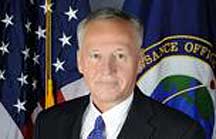
The 17th director of the NRO, Gen. Carlson has a broad space and intelligence background. A command pilot with more than 3,500 flying hours in ten different aircraft, his flying assignments included commanding the Air Force's first stealth fighter wing, the 49th Fighter Wing at Holloman AFB, N.M. His staff assignments included positions at Tactical Air Command, Headquarters U.S. Air Force, and the offices of the secretary of the Air Force and secretary of defense. He also served as the director of force structure, resources and assessment on the Joint Staff; commander of the 8th Air Force, Barksdale AFB, La.; and joint functional component commander for Space and Global Strike, U.S. Strategic Command, Offutt AFB, Neb. Prior to his retirement from the U.S. Air Force, Gen. Carlson served as commander of Air Force Materiel Command, Wright-Patterson AFB, Ohio, which is responsible developing, testing, acquiring, and sustaining Air Force weapons systems. He was promoted from lieutenant general to general in 2005.
Among Gen. Carlson's many awards and decorations are the Defense Distinguished Service Medal with oak leaf cluster, Distinguished Service Medal with oak leaf cluster, Legion of Merit, the Meritorious Service Medal with two oak leaf clusters, the Air Force Commendation Medal with two oak leaf clusters, and the Order of the Sword, Air Force Materiel Command. He graduated with distinction from the Air Force ROTC program at the University of Minnesota, Duluth, and holds a master's degree from Webster University, St. Louis, Missouri.
The agenda also includes three decades of directors of the NRO moderated by Gen. Thomas S. Moorman, Jr., USAF (Retired), former chairman of the Space Foundation Board of Directors. The NRO panel comprises: Hans Mark, Ph.D., under secretary of the Air Force/secretary of the Air Force and NRO director, 1977-1979; Edward C. Aldridge, Jr., under secretary of the Air Force/secretary of the Air Force and NRO director, 1981-1988; Martin C. Faga, assistant secretary of the Air Force for space and NRO director, 1989-1993; Jeffrey K. Harris, assistant secretary of the Air Force for space and NRO director, 1994-1996; Keith R. Hall, assistant secretary of the Air Force for space and NRO director, 1997-2001; Peter B. Teets, under secretary of the Air Force and NRO director, 2001-2005; Donald M. Kerr, Ph.D., assistant to the secretary of the Air Force (Intelligence Space Technology) and NRO director, 2005-2007; Scott F. Large, assistant to the secretary of the Air Force (Intelligence and Space Technology) and NRO director, 2007-2009.
Headquartered in Chantilly, Virginia, the NRO develops and operates space reconnaissance systems, conducts intelligence-related activities essential for U.S. national security, and coordinates collection and analysis of information from airplane, Central Intelligence Agency (CIA), and military satellite reconnaissance. Its products identify potential trouble spots around the world, support military planning, and monitor the environment.
Funded through the National Reconnaissance Program, which is part of the National Foreign Intelligence Program, the NRO is part of the Department of Defense (DoD) and is one of 16 members of the U.S. intelligence community. Its 3,000 employees are jointly staffed by the armed services, CIA, and DoD. Carlson reports to both the director of national intelligence and the secretary of defense and also serves as the assistant to the secretary of the Air Force (Intelligence Space Technology). The NRO was established in 1961 as a classified DoD department and was declassified in 1992.
About the 26th National Space Symposium The 26th National Space Symposium will cover all the critical facets of the space industry, presented by the people who are making the decisions, running the companies, establishing the policies, and setting the course for the future. It includes workshops, forums, panels, and presentations covering all aspects of space plus a spectacular Opening Ceremony; the General James E. Hill Lifetime Space Achievement Award luncheon honoring legendary astronaut John Young; a Congressional Luncheon; the Corporate Partnership Dinner; and the Space Technology Hall of Fame® Dinner, which honors technologies, organizations, and individuals for transforming space technology into commercial products that improve life on Earth. The Symposium also includes engaging programs for selected teachers and students and the extensive AMERICOM Government Services (AGS) Exhibit Center.
Online registration and more information, including agenda, speakers, and exhibitors, are available at.

